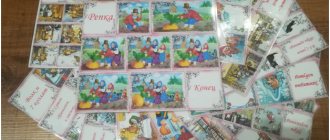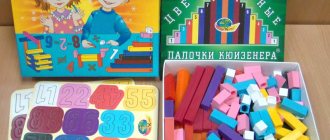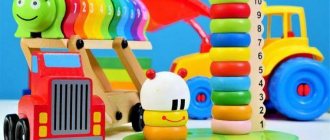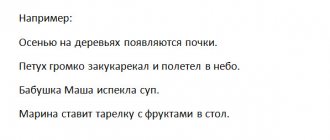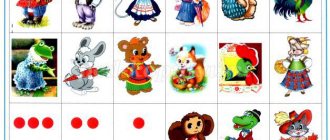The use of mnemonics in the development of speech in preschool children
It's no secret that children with general speech underdevelopment have the following problems: a poor vocabulary, inability to coordinate words in a sentence, and impaired sound pronunciation. Most children have impaired attention and imperfect logical thinking. Therefore, speech therapy in eliminating general speech underdevelopment is a very difficult matter. It is necessary to teach children to express their thoughts coherently, consistently, and grammatically correctly, and to talk about various events from the surrounding life.
In preschool age, visual-figurative memory predominates, and memorization is mainly involuntary: children better remember events, objects, facts, and phenomena that are close to their life experience. The volume of visual memory and the possibility of semantic, logical memorization in children with ODD practically does not differ from the norm, but their auditory memory and memorization productivity are noticeably reduced.
When teaching children coherent speech, it is entirely justified to use creative methods, the effectiveness of which is obvious, along with generally accepted ones. Mnemonics techniques facilitate memorization in children and increase memory capacity through the formation of additional associations.
Mnemonics is a set of rules and techniques that facilitate the process of memorizing information.
K. D. Ushinsky wrote: “Teach a child some five words unknown to him - he will suffer for a long time and in vain, but connect twenty such words with pictures, and he will learn them on the fly.” Since visual material is better absorbed by preschoolers, the use of mnemonic tables in classes on the development of coherent speech allows children to more effectively perceive and process visual information, save and reproduce it. The peculiarity of the technique is the use of symbols rather than images of objects.
This technique makes it much easier for children to find and memorize words.
Mnemonics helps develop:
‒ associative thinking
‒ visual and auditory memory
‒ visual and auditory attention
- imagination
An example is the familiar phrase “Every Hunter Wants to Know Where the Pheasant Sits,” which helps to remember the colors of the rainbow.
The use of mnemonics in preschool age occupies a large place. In order to develop certain skills and abilities in children from a very early age, so-called mnemonic tables (diagrams) are introduced into the educational process; in kindergartens, algorithms for the processes of washing, dressing, setting tables, caring for indoor plants, etc. are often used.
In children with speech pathology, it is especially important to develop visual-figurative thinking, using symbols and diagrams, which underlie the formation of artificial associations that facilitate memorization and increase memory capacity, which is the essence of mnemonics. Reliance on a visual image is very important and mandatory, since if, when reproducing the text, this visual image does not appear in the imagination, then the child does not understand this text. Thus, the technique of symbolization is the shortest way to forming the process of memorization and accurate transmission of information that requires verbatim repetition, for example in poetry.
Mnemonic charts serve as didactic material in my work on the development of coherent speech in children. I use them for:
- enrichment of vocabulary,
- when learning to write stories,
- when retelling fiction,
- when guessing and making riddles,
- when memorizing poetry.
Effectively use mnemonic tables in mathematical development. In my work I widely use Dienesha blocks. With the help of blocks, the names of colors and shapes are fixed, logical thinking and speech are developed. With the help of property cards, children can very easily characterize blocks.
For this, a schematic representation of the individual parts is sufficient, which will facilitate memorization and subsequent reproduction of the entire image in rhymed form. Mnemonic tables are especially effective when learning poems. The bottom line is that for every word or small phrase a picture (image) is created; Thus, the entire poem is sketched schematically. After this, the child reproduces the entire poem from memory, using a graphic image. At the initial stage, the adult offers a ready-made plan - a diagram, and as the child learns, he is also actively involved in the process of creating his own diagram.
The use of modeling facilitates and speeds up the process of memorizing and assimilating texts, and forms techniques for working with memory. With this type of activity, not only auditory, but also visual analyzers are turned on. Children easily remember the picture and then remember the words.
Mastering the techniques of working with mnemonic tables significantly reduces training time. Using supporting drawings to teach memorizing poems captivates children and turns the activity into a game. The visual image that the child retains after listening, accompanied by viewing the drawings, allows him to remember the text much faster. To learn each poem, its own mnemonic table is developed and compiled. And so, step by step, a mnemonic table is created. The next stage of working with the mnemonic table is an emotional, expressive reproduction of the text of the poem. Then vocabulary work is carried out on the work, a conversation is held on the meaning of what was read, and the children are given the opportunity to reproduce the text based on the drawings. During my work in the compensatory group for children with severe speech impairments, a series of mnemonic tables were created for poems on various topics. The main thing is to convey a conventionally visual diagram, to depict it in such a way that what is drawn is understandable to children.
At first glance, pictures that are not related to each other can be combined into one plot, with the help of which signal schematic images help to activate thought processes. Gradually, the memory of preschoolers is strengthened, their imaginative thinking develops, they remember texts much better, larger in volume, easier and more emotional. With this method of working, the entire poem is remembered. Learning has become a fun, emotional activity for preschoolers, and at the same time the content of the text is tangible, visible, imaginable. After all, one of the rules for strengthening memory and speech says: “When you learn, write down, draw diagrams, draw graphs.”
These diagrams serve as a kind of visual plan for creating monologues and help children build:
- story structure,
- sequence of the story,
- lexical and grammatical content of the story.
When introducing fiction and teaching how to write stories, I widely use mnemonics. Together with the children, we talk through the text, look at the illustrations and track the sequence of the previously prepared model for this work.
After developmental classes using mnemonic tables, children most easily compose fairy tales on almost any topic, using vocabulary, observing the general principles of plot construction. These fairy tales reflect the child’s own experiences and his understanding of the life around him.
But it should be noted that preschoolers begin to experience some difficulties, since it is difficult to follow the proposed model plan. Very often, the first stories based on models turn out to be very sketchy. To reduce these difficulties as much as possible, it is necessary to introduce tasks to activate and enrich the vocabulary into the software content of each mnemonic table.
Model schemes can also be used in other classes.
Mnemonic tables are not limited to all work on the development of coherent speech in children. This is, first of all, the initial, most significant and effective work, since the use of mnemonic tables allows children to more easily perceive and process visual information, save and reproduce it.
In parallel with this work, speech games are necessary, the use of board-printed games is mandatory, which help children learn to classify objects, develop speech, visual perception, imaginative and logical thinking, attention, observation, interest in the world around them, and self-test skills.
Literature:
- Bolshova, T.V. Learning from a fairy tale. Development of thinking in preschoolers using mnemonics. St. Petersburg, 2005.
- Vakhrushev, A.A., Kochemasova, E.E., Akimova, Yu. A. Hello, world! Moscow “Balass”, 2000.
- Volkovskaya, T.N., Yusupova G.H. Psychological assistance to preschool children with general speech underdevelopment. M., 2004.
- Maletina N. S., Ponomareva L. V. Modeling in descriptive speech of children with special needs / Preschool education. 2004.№ 6. pp. 64–68.
- Omelchenko L.V. The use of mnemonic techniques in the development of coherent speech / Speech therapist. 2008. No. 4. P. 102 -115.
- Tkachenko T. A. The use of diagrams in the compilation of descriptive stories / Preschool education. 1990. No. 10. P.16–21.
Common speech problems in preschool children
In most cases, girls and boys of preschool age should already be able to fully operate with synonyms and a variety of images, describe all current events, using vivid, but at the same time grammatically correct word forms. But, unfortunately, not all preschoolers can boast of such skills. Most children face various speech problems:
- Inability to compose long, complex sentences - the child’s speech consists exclusively of simple, laconic sentences.
- The child cannot independently formulate a logically correct and complete sentence.
- Systematic use of non-literary vocabulary.
- Minimal, poor vocabulary that does not correspond to the child’s age category.
- A preschooler cannot independently formulate questions and answer questions posed.
- Poor level of diction.
- A preschooler cannot draw correct logical conclusions and statements.
To correct such speech defects, mnemonics are often used, which have become widespread among many specialists.
Features of using mnemonic tables for teaching children
Today, mnemonics are one of the easy-to-use, easy, convenient and highly effective techniques for the development of coherent children's speech and accelerated memorization of material, which are implemented through schematic mnemonic tables and graphic images.
At the same time, this technique helps to formulate the baby’s speech, replenish his vocabulary with beautiful, complex and correctly constructed phrases and sentences. The essence of all mnemonic techniques is the transformation of textual, verbal information into visual images. Despite the fact that many preschool-aged children perceive their first lessons very painfully, believing that they will not succeed, in the future the children really enjoy the educational process. Not only is it extremely informative, but it is also very interesting, engaging and fun, like a game.
Most often, in the case of using mnemonic tables for the development of coherent speech of preschoolers in preschool institutions, the following scheme is used:
- The teacher shows the children cards with bright and colorful pictures indicating a certain phrase or sentence.
- The next stage is the study of so-called mnemonic tracks. This is a series of pictures, consisting of about four images, with the help of which the child can tell a simple story.
- The most difficult stage is the direct use of the mnemonic table for teaching coherent speech to preschoolers. Thanks to this method, preschool children learn to reproduce longer and more complex stories and stories.
Varieties of mnemonic devices for the development of coherent speech in preschoolers:
- Cards with an algorithm for certain actions - for example, the sequence of morning activities (washing, brushing teeth, breakfast, getting dressed).
- Mnemonic tracks with a series of different images that tell a specific story or story. For children of primary preschool age, fairy tales are most often used.
- Techniques for faster and easier assimilation of information and study of poetry.
An example of using the fairy tale “The Three Little Pigs”.
An example in the use of a poem.
Production of mnemonic tables
Making educational mnemonic tables for speech development does not require any special skills or artistic talent. A word or short phrase is selected, as well as an image that will clearly illustrate the selected word.
For children of primary preschool age, it is best to use tables with bright, colorful pictures - thanks to images of a squirrel, bunny or flower, the child remembers the material much faster and easier.
After some time, after the children have carefully studied the phrase and the image that characterizes it, you can replace the picture with graphic symbols. For example, draw a Christmas tree with a green triangle, and a hare with a gray or blue circle. Below is shown how, using the example of the fairy tale “Ryaba Hen,” you can make mnemonic tables with gradual complication in the form of replacing pictures with graphic symbols:
Mnemonic table with pictures only.
Add some graphic symbols.
Replace all pictures with graphic symbols.
Most often, for the development of coherent speech in preschool children, ready-made diagrams and tables developed by V.K. Vorobyova or T.A. Tkachenko. But it is worth remembering that such model schemes cannot be called universal - they can only become the basis in the learning process of each individual child. The teacher can independently refine, improve and correct ready-made model diagrams.
In most cases, educational mnemonic tables are used to teach children the main features of a particular subject. Therefore, the main topics in such tables may be the study of the color, shape, size, texture (soft or hard) of a particular object. In addition, the educational mnemonic table can answer the following question:
- What elements does this item consist of?
- What is this thing used for?
- What can you do with this item and what can’t you do with it?
This is an approximate list of questions that the child should answer after studying cards with images and mnemonic tables.
What is mnemonics?
Mnemonics – literally translated from Greek means “the art of memorization.” This is a certain system of techniques and methods, the action of which is aimed at the most effective preservation, reproduction and memorization of the received material.
The name of this technique is absolutely no coincidence - it comes from the name of the ancient Greek goddess of memory, logic and prudence named Mnemosyne. Mnemonics is a popular technique, the essence of which is the most accelerated development of coherent speech, based on the visual perception of information with its further reproduction using images.
The main point of using a mnemonic table for children is the following: to determine a specific word or phrase, a specific image (picture) is used, with the help of which a schematic sketch of the word is made. By carefully studying the presented images, the child can quickly memorize and reproduce text material, which helps the development of speech for preschoolers.


